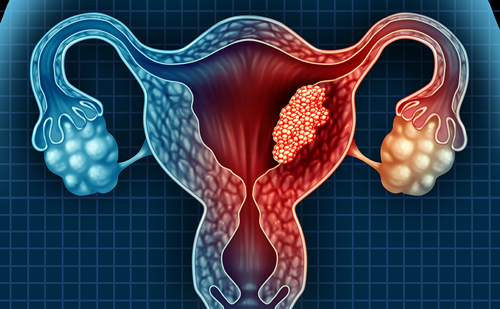This article represents a short, personal selection of emerging issues in gynaecological oncology and, consequently, should not be considered a comprehensive overview of this complex issue.
Lymphadenectomy for Endometrial Cancer
Based on evidence that pelvic lymphadenectomy does not have any therapeutic benefit in the treatment of endometrial cancer, Todo et al. recently published an interesting paper in the Lancet1 concerning the real benefits of surgical treatment with complete, systematic lymphadenectomy and para-aortic lymphadenectomy in patients with intermediate and high-risk endometrial cancer. The authors selected 671 patients with endometrial carcinoma who were treated either with complete, systematic pelvic lymphadenectomy (n=325) or with combined pelvic and para-aortic lymphadenectomy (n=346) between January 1986 and June 2004 at two tertiary centres in Japan. Patients at an intermediate or high risk of recurrence were offered adjuvant radiotherapy or chemotherapy. The primary outcome measured was overall survival. Overall survival was significantly greater in the pelvic and para-aortic lymphadenectomy group than in the complete, systematic pelvic lymphadenectomy group (hazard ratio [HR] 0.53; 95 % confidence interval [CI] 0.38–0.76; p=0.0005). This association was also recorded in 407 patients at intermediate or high risk of recurrence (p=0.0009) but in this study, overall survival was not related to lymphadenectomy type in low-risk patients. A multivariate analysis of prognostic factors showed that, in patients with an intermediate or high risk of recurrence, pelvic and para-aortic lymphadenectomy reduced the risk of death compared with complete, systematic pelvic lymphadenectomy (HR 0.44; 95 % CI 0.30–0.64; p<0.0001). An analysis of 328 patients at intermediate or high risk of recurrence, who were treated with adjuvant radiotherapy or chemotherapy, showed that patient survival improved with pelvic and para-aortic lymphadenectomy (HR 0.48; 95 % CI 0.29–0.83; p=0.0049) and with adjuvant chemotherapy (HR 0.59; 95 % CI 0.37–1.00; p=0.0465) independently of one another.
The authors concluded that combined pelvic and para-aortic lymphadenectomy is recommended in patients with endometrial carcinoma with an intermediate or high risk of recurrence. If a prospective randomised or comparative cohort study is planned to validate the therapeutic effect of lymphadenectomy, it should include both pelvic and para-aortic lymphadenectomy in patients at an intermediate or high risk of recurrence.
Best Management of Clear-Cell Endometrial and Uterine Papillary Serous Carcinomas
Although less common than endometrioid endometrial carcinoma, clear-cell endometrial carcinoma (CCE) and uterine papillary serous carcinoma (UPSC) account for a disproportionate number of endometrial cancer-related deaths. Because of the low incidence of UPSC and CCE histotypes, to date only a limited number of prospective trials exist from which evidence-based management can be developed. Two Society of Gynecologic Oncologists (SGO) reviews try to answer this question. Clinical practice guidelines from the SGO regarding chemotherapy suggest a platinum-based doublet or triplet combination with paclitaxel and/or doxorubicin for CCE2 and a platinum/taxane-based regimen for UPSC.3 Randomised trials directly comparing these regimens are now underway, many of which within the Gynecologic Oncology Group. Clear-Cell Endometrial Carcinoma
For the SGO review of CCE,2 MEDLINE was searched between 1 January 1966 and 31 December 2008 for all publications in English in which the studied population included women diagnosed with CCE. Qualifying studies had at least 30 patients. CCE histology is diagnosed in fewer than 6 % of all endometrial cancers and its incidence increases with age. Furthermore, CCE histology is morphologically and genetically different from that of the more prevalent endometrioid endometrial cancer, sharing many similarities with clear-cell neoplasms of the ovary and kidney. Comprehensive surgical staging is critical in order to plan appropriate postoperative management. Adjuvant pelvic and/or whole abdominal radiotherapy has not been clearly shown to be beneficial in women diagnosed with CCE. Adjuvant chemotherapy with cisplatin, Taxol® and doxorubicin, either in a doublet or triplet combination, has demonstrated efficacy.
Uterine Papillary Serous Carcinoma
For the SGO review of UPSC,3 MEDLINE was searched for all research articles published in English between 1 January 1966 and 1 May 2009 in which the studied population included women diagnosed with UPSC. Although preference was given to prospective studies, qualifying studies were not limited by design or by the number of subjects, given the paucity of available reports. Women affected by UPSC often presented with postmenopausal bleeding but also presented with abnormal cervical cytology, ascites or a pelvic mass. In some cases, the diagnosis was made by endometrial biopsy, while in other cases it was not made until the time of definitive surgery. Metastatic disease was common and best identified via comprehensive surgical staging. Local and distant recurrences occur frequently, with extra-pelvic relapses reported most commonly. Optimal cytoreduction and adjuvant platinum/taxane-based chemotherapy appeared to improve survival, while adjuvant radiotherapy may have contributed to loco-regional disease control. Women diagnosed with UPSC should undergo comprehensive surgical staging and an attempt at optimal cytoreduction. Platinum/taxane-based adjuvant chemotherapy should be considered in the treatment of both early- and advanced-stage patients.
Predicting Optimal Cytoreduction in Ovarian Cancer Using Serum CA-125 Titre
Is the preoperative serum CA-125 titre correlated with optimal/ suboptimal surgical cytoreduction? This is an exciting question, which a meta-analysis4 based on 14 international studies attempts to answer. In addition, the authors retrospectively reviewed data of 154 patients with ovarian cancer. Using the bi-variate model, the diagnostic performance of CA-125 was assessed at various cut-off levels. An overall odds ratio was obtained using the random effects model. A total of 2,192 patients were included in the analysis. The pooled optimal cytoreduction rate was 53.7% and the mean of pooled median CA-125 levels was 580 U/ml. At the 500U/ml cut-off level, sensitivity and specificity were 68.9 % (95 % CI 62.0–75.1) and 63.2 % (95 % CI 53.7– 71.7), respectively. The positive and negative likelihood ratios were 1.87 (95 % CI 1.40–2.50) and 0.49 (95 % CI 0.37–0.66), respectively. CA-125 titre >500 U/ml showed a strong association with suboptimal cytoreduction, with an odds ratio of 3.69 (95 % CI 2.02–6.73). This analysis indicates that CA-125 titre is a strong risk factor for suboptimal cytoreduction and may be applied in preoperative counselling and treatment planning. However, it also shows that CA-125 titre cannot predict optimal cytoreduction accurately.
Multiple Conisation Procedures Increase the Risk of Preterm Delivery
What is the impact of one or two conisations on preterm delivery and perinatal mortality in subsequent pregnancies? A population-based cohort study was conducted at the Aarhus University Hospital in order to evaluate preterm delivery and mortality rates in 721 deliveries after one conisation and in 37 deliveries after two conisations, compared with 390 deliveries after dysplasia and 74,552 deliveries that were not preceded by either conisation or dysplasia.5 The Cox regression model was used to evaluate preterm delivery rates and perinatal mortality. The main outcome measures were: birthweight; gestational age (<28, <32 and <37 weeks of gestation); and perinatal mortality. The authors found that the risk of preterm delivery increased after one conisation (adjusted HR <37 weeks: 2.8 [95 % CI 2.3–3.5]; adjusted HR <28 weeks: 4.9 [95 % CI 2.5–9.7]) and that this risk further increased after two conisations (adjusted HR <37 weeks: 9.9 [95 % CI 6–17]; adjusted HR <28 weeks: 9.8 [95 % CI 1.4–70]), compared with no conisation. One conisation was associated with an increased perinatal mortality (adjusted HR <28 weeks: 9.9 [95 % CI 4.0–25]). All three methods of conisation [large loop excision of the transformation zone, electroknife and cold knife] increased the risk of preterm delivery. The authors concluded that a single conisation is associated with a 2.8-fold increase in the risk of perinatal death, most likely because of a 4.9-fold increase in extreme preterm delivery. Only 37 patients underwent two conisations and the results showed a tenfold increase in the risk of preterm delivery.How Often Does Human Papillomavirus Cause Invasive Cervical Cancer?
A better understanding of the worldwide prevalence and distribution stability of human papillomavirus (HPV) genotypes in invasive cervical cancer is crucial to guide the introduction of prophylactic vaccines. A simple, large and elegant study6 was performed by an international group of researchers based on paraffin-embedded samples of histologically confirmed cases of invasive cervical cancer, collected from 38 countries across Europe, North America, South America, Africa, Asia and Oceania. HPV detection in pathologically confirmed, primary invasive cervical cancer was achieved via polymerase chain reaction (PCR) using SPF10 HPV broad-spectrum primers and was followed by enzyme immunoassay and genotyping using a reverse hybridisation line probe assay. Sequence analysis was performed to characterise HPV-positive samples with unknown HPV types. Data analyses included algorithms of multiple infections to estimate type-specific relative contributions. 22,661 paraffin-embedded samples were obtained from 14,249 women. 10,575 cases of invasive cervical cancer were included in the study, 8,977 (85 %) of which were positive for HPV DNA. The most common HPV types were 16, 18, 31, 33, 35, 45, 52 and 58: together, these HPV types comprised 8,196 of the 8,977 cases of invasive cervical cancer worldwide (91 %, 95 % CI 90–92). HPV types 16 and 18 were detected in 6,357 of 8,977 cases (71 %, 95 % CI 70–72) of invasive cervical cancer. HPV types 16, 18 and 45 were detected in 443 of 470 cases (94 %, 95 % CI 92–96) of cervical adenocarcinomas. Unknown HPV types, identified by sequence analysis (26, 30, 61, 67, 69, 82 and 91), accounted for 103 (1 %) of 8,977 cases of invasive cervical cancer. Women with invasive cervical cancers related to HPV types 16, 18 or 45 presented at a younger mean age than those with other HPV types (50.0 years [49.6–50.4], 48.2 years [47.3–49.2], 46.8 years [46.6–48.1] and 55.5 years [54.9–56.1], respectively).
To our knowledge, this study is the largest assessment of HPV genotypes to date. HPV types 16, 18, 31, 33, 35, 45, 52 and 58 should be given priority firstly, when the cross-protective effects of current vaccines are assessed and secondly, for the formulation of recommendations for the use of second-generation, polyvalent HPV vaccines. These results also suggest that type-specific, high-risk, HPV DNA-based screening tests and protocols should focus on HPV types 16, 18 and 45.
Future Perspectives in Gynaecological Oncology
A preventative HPV vaccine for cervical cancer; appropriate use of HPV DNA testing for cervical cancer; screening for familial cancer syndromes in ovarian, breast and endometrial cancer; tailored and combined surgery for endometrial cancer; and more widespread use of intraperitoneal chemotherapy for ovarian cancer are just some of the challenging, cutting-edge approaches proposed in gynaecological oncology at present. Significative evidence of their efficacy in preventing, diagnosing and treating selected patients at risk for or affected by gynaecological cancers has already been demonstrated in the literature. In order to obtain the best results and translate this innovative approach to daily specialist practice, however, an innovative and accurate method of data collection is necessary, which explores the real financial and medical feasibility of these new approaches in the present and future worldwide scenarios, characterised by shortage of money for health. Moreover, the exact rate of attended/induced morbidity and/or mortality must be determined based on large clinical trials; not only those obtained in selected, high-quality centres but also in standard-quality centres.







